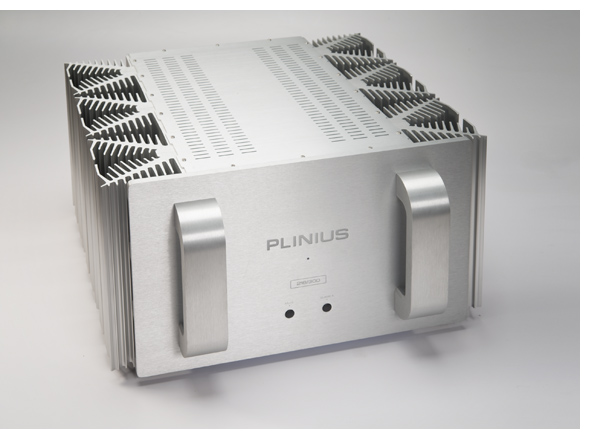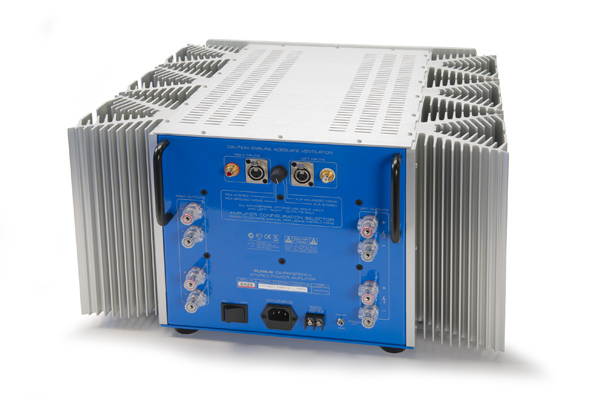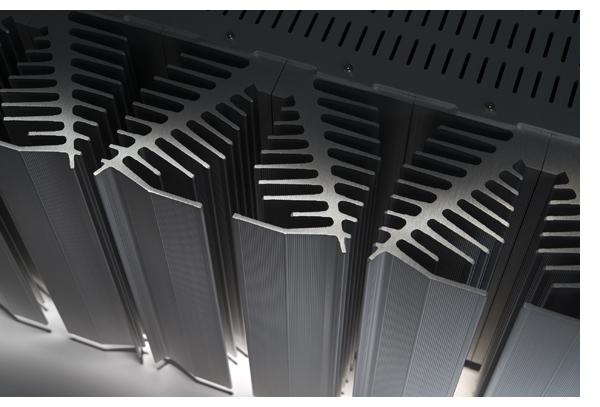 Located in New Zealand, Plinius has been making great components for years, and the brand has a loyal customer base that sings the Plinius praises on most of the audio forums. And with good reason. Every Plinius product we’ve had the privilege to audition at TONEAudio has always exceeded expectation.
Located in New Zealand, Plinius has been making great components for years, and the brand has a loyal customer base that sings the Plinius praises on most of the audio forums. And with good reason. Every Plinius product we’ve had the privilege to audition at TONEAudio has always exceeded expectation.
The company’s top-of-the-line power amplifier, the SA-Reference, is no different. Plinius has always stood for great value and high performance, but this amplifier is in an entirely different league. Tipping the scale at 125 pounds and costing $20,900—both reasonable figures compared to some of its competitors—this is truly a destination product. Every SA-Ref is hand built and tested in the New Zealand factory. These massive amplifiers are available in a finish that Plinius refers to as “linishing,” and is offered in a black or silver anodized color as the one you see here. With large and conveniently placed handles on both the front and rear of the amp make it easy enough for those who aren’t Olympic deadlifters to move the amp into place.
Flanked with distinctive heat sinks on both sides, this Class-A masterpiece lives up to its nature by producing a lot of heat. But, in comparison to my reference Pass Xs 300 monoblocks, the heat is manageable. For those feeling a bit greener, there is a switch on the front panel that allows the amplifier to be run in Class-AB mode, which drops the idle power consumption down from 1,100 watts to 184 watts. During the course of this review, I leave the amplifier on in AB mode all the time, switching to Class A at the beginning of the day. This shortens the time to thermal stabilization and dramatically cuts power consumption. Operated thusly, the SA-Ref takes about 30 minutes to come out of the fog and do its thing.
At first blush, the difference in sound quality going from A to AB doesn’t seem as great, but extended listening validates burning the extra electricity. Again drawing the comparison to the Pass amplifiers, the SA-Ref goes from great to sublime in Class-A mode. I say drive a few less miles or keep the lights low if you’re feeling guilty about the power consumption. Your ears will thank you.
Major Microdynamics
Even with a musical selection that is relatively lacking in dynamics, like the Zombies’ “Tell Her No,” the wealth of texture that the SA-Ref provides will have you immediately under its spell. A similar effect is achieved with Neil Young’s classic bootleg Time Fades Away. This recording has lackluster quality at best, yet when delivered via an amplifier that can extract so much musical detail, the music feels closer than ever without sounding etched. On the title track, the piano in the background is usually almost indecipherable, but the combination of the SA-Ref and the $85,000-per-pair Dynaudio Evidence Platinum speakers gives this flat recording some depth, helping those small, fun details rise to the surface.
Let’s face it—we all have records in our collection that we love, even though they might live up to audiophile standards. The SA-Ref goes a long way towards making a wider range of your music collection more enjoyable—and that’s a great thing.
Going upscale with source material reaps even bigger rewards. Tracking through a 24-bit/192-kHz version of Neil Young’s Harvest reveals precious levels of detail and ambience, which bring new life and renewed clarity to this brilliant recording. The grungy, distorted guitar at the beginning of “Alabama” blasts off the walls of my listening room. I can almost hear the grill cloth on Young’s guitar amplifier move—fantastic. It’s this wealth of nuance that makes the SA-Ref a world-class component.
Admittedly, this reviewer is a huge fan of Class-A solid-state amplifiers; the additional tonal warmth (over most Class-AB amps), combined with the tremendous bass grip of properly designed amps, makes you wonder if the glass bottles are really necessary. The SA-Ref is one of these rare amplifiers indeed.
The SACD of the Art of Noise’s Daft features a lot of trippy, spatial effects, with organic and synthesizer sounds floating around all three axis of the soundstage via the dCS Vivaldi digital player. The track “Who’s Afraid (of the Art of Noise)” is perhaps the biggest sounding of the bunch, with playful female vocals thrown in the mix far left and far right, with plenty of giggling and heavy breathing punctuated by the occasional “boo, boo” added for good measure. No, this amp won’t necessarily reveal the tonality of a Stradivarius violin, but it is big fun—and through an amplifier that can’t throw a massive soundstage, this recording sounds incredibly dead. The SA-Ref passes this test easily, with the big Dynaudios disappearing in the listening room like a pair of minimonitors.
On Elvis Costello’s duet with Burt Bacharach, “What’s Her Name Today?” the piano floats slightly in front of the imaginary line between the tweeters, with the strings just behind Costello’s voice, which takes on a height that makes it feel like he’s standing in the room singing. Every breath of his delicate falsetto, which grows to a major bellow at the end, is reproduced with just the right amount of dynamics and effort, again suggesting the real thing.
When I switch the program to heavy rock, the SA-Ref delivers the goods. And what better way to prove it than with the Audio Fidelity 24 Karat Gold CD of Judas Priest’s Hell Bent For Leather? Cranking the ARC REF 5SE preamplifier up to 70 (forget about 11) drives the KEF Blades, which are now back in the system at bone-crushing levels. While I find myself looking for a lighter to hold up, the SA-Ref motors through.
After about an hour of listening at levels well beyond reasonable and prudent, sifting through Black Sabbath, the Black Keys and Black Country Communion, I turn down the volume to reflect. My ears have given up, but the SA-Ref simply cannot be pushed to clipping when driving a pair of speakers with 88 dB or 90 dB sensitivity ratings. And so—while they are unsuitable matches for an amplifier of this quality—I bring out the power-hungry Magnepan 1.7s, just to probe how far the SA-Ref can be pushed.
Should you manage to push this amplifier to clipping, it does so softly and gently, with only a slight reduction in the overall soundfield. Fortunately, if you require this much power, the SA-Ref can be converted to mono operation with the flip of a switch on the rear panel. It is now capable of delivering 1,000 watts into an 8-ohm load and 1,800 watts into 4 ohms. The SA-Ref is a model of simplicity, allowing balanced XLR or standard RCA inputs, and it proves compatible with all of the preamplifiers at my disposal, from Audio Research, Burmester, Conrad-Johnson, Nagra, Robert Koda and Simaudio.
The Art of Relaxation
As days roll by with the SA-Ref in the system, it is clear that this is one of the few solid-state amplifiers that combines a freedom from distortion with effortless dynamics, and that it can just get out of the way of the music and quickly get you into the relaxation zone. And isn’t that the ultimate pleasure a premium hi-fi system should provide?
Pressurizing the sound room can be captivating for many listeners, but those subscribing to the “first watt” philosophy of sound will not be disappointed either. Even at low volume, the SA-Ref has plenty of finesse and acquits itself like a low-parts-count, low-power amplifier, providing a richness of tonal contrast that will make you want to pop the top to see if there really aren’t some tubes lurking inside. I briefly return to the Black Keys and discover that the guitar on the gentle intro of “Lies” just floats between the speakers while dripping with echo and decay.
Easing back into the couch with Arnold Bax’s Symphony No. 4 is even more soothing. That extra power on tap, combined with a very neutral tonality, makes this amplifier a delight when delivering large-scale orchestral pieces. It paints a big soundscape with both width and depth, and it is able to keep the smallest details rendered while easily and adequately capturing the scale of even the loudest passages.
How does the SA-Ref stack up to some of its similarily priced competitors? Quite well, in fact. The Pass Xs300s are a bit unfair, as they break the bank at $84,000—and, in all honesty, when I switch back and forth, the Pass amps take the lead in terms of resolution and a more dreamy, more realistic presentation. The SA-Ref sounds slightly etched and small in this unfair comparison.
However, when I go back to a couple of comparably priced competitors—the Burmester 911 MK3 ($29,900), the D’Agostino Momentum Stereo ($29,000) and the Audio Research REF 250s ($25,000 per pair)—the SA-Ref holds its own to the point of simply differing from these other amps. It would be like comparing the Audi S4, BMW M3 and Mercedez AMG C Class, which are all high-performance machines, to be sure, but each has its own take on how said performance should be delivered.
When paired with all the speakers at my disposal—KEF Blade, GamuT S9, Dynaudio Platinum and Focal Maestro Utopia, which are all reference speakers in their own right—the SA-Ref provides a sound slightly warmer than the tubed ARC monos can, yet not quite as warm as that of the Burmester. The D’Agostino is probably the most neutral of the four, but these are very, very fine hairs we are splitting here. Considering that the SA-Ref will set you back a comparatively less expansive $22,000, it really is a bargain for the sticker price.
In the End…
…We’re all dead, but while you’re still living and possessing decent hearing and cash flow, I highly suggest considering the Plinius SA-Ref amplifier. If you want a destination amplifier that can convert to monoblock (should you need more power at some point) and if you love the concept of a Class-A solid-state amplifier that will never need tubes replaced, this just might be your baby.
SA-Reference Power Amplifier
MSRP: $20,900
Peripherals
| Analog Source | AVID Acutus REF SP turntable Lyra Atlas cartridge TriPlanar tonearm |
| Phonostage | Indigo Qualia |
| Digital Source | dCS Vivaldi stack Sooloos Control 15 Aurender S10 |
| Preamplifiers | Audio Research REF 5 SE Burmester 011 Robert Koda K-10 |
| Speakers | GamuT S9 Dynaudio Evidence Platinum KEF Blade |
| Cable | Cardas Clear |
| Power | IsoTek |
















